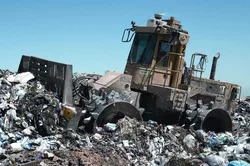
If you live near a landfill, you need to be especially aware of the ways in which toxic chemicals from the landfill can threaten your family. For example:
·Groundwater contamination: Over time, rainwater mixes with the chemicals from the garbage dumped in the landfill and produces a “leachate”, a sort of toxic sludge that burrows its way down through the landfill and ultimately into the groundwater. (That is, unless there is adequate lining at the landfill’s bottom, which, for older landfills, is seldom present.) The leachate-contaminated groundwater then migrates in whatever direction nature takes it, possibly into a nearby neighborhood’s water supply.
·Methane Gas: The process of compacting landfill waste produces methane-a gas 21 times more potent than carbon dioxide. Methane is most dangerous if it blows out the side of a landfill-under the ground surface-and migrates into a nearby neighborhood, where it can collect in the confined spaces of homes, and create an explosion risk.
The most dangerous landfills are those which began accepting waste many years ago, usually before 1980. These landfills may have been constructed and operated under rules that did not really protect the surrounding environment or people. As a result, the landfill may have accepted highly toxic waste that it should not have, and this waste will make the leachate all the more dangerous should it reach the groundwater. Also, older landfills often did not have effective liners-or any liners at all-and so there is nothing to impede the contamination as gravity and percolation from the rain pushes it down toward the groundwater. Finally, because older landfills’ sides were often not adequately constructed, there is little resistance to methane gas bursting out, and travelling in whatever direction nature allows.
https://environmentvictoria.org.au/resource/problem-landfill/

"*" indicates required fields